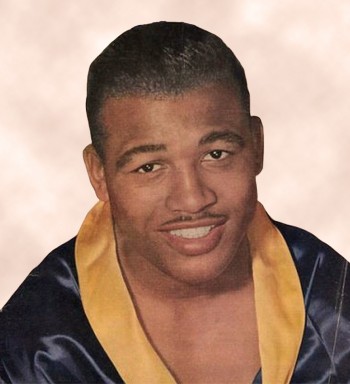Sugar Ray Robinson (Walker Smith)

Sugar Ray Robinson
Robinson was a fluid boxer who possessed a quick jab and knockout power. He possessed tremendous versatility—according to boxing analyst Bert Sugar, “Robinson could deliver a knockout blow going backward.” Robinson was efficient with both hands, and he displayed a variety of effective punches—according to a TIME magazine article in 1951, “Robinson’s repertoire, thrown with equal speed and power by either hand, includes every standard punch from a bolo to a hook—and a few he makes up on the spur of the moment.” Robinson commented that once a fighter has trained to a certain level, their techniques and responses become almost reflexive. “You don’t think. It’s all instinct. If you stop to think, you’re gone.”
Robinson has been ranked as the greatest boxer of all time by sportswriters, fellow boxers, and trainers. The phrase “pound for pound“, was created by sportswriters for him during his career as a way to compare boxers irrespective of weight, and Hall of Fame fighters such as Muhammad Ali, Joe Louis, Roberto Duran and Sugar Ray Leonard have ranked Robinson as the greatest pound for pound boxer in history.[66][70][71] In 1997, The Ring ranked him as the best pound for pound fighter in history,[9] and in 1999, he was named “welterweight of the century,” “middleweight of the century,” and overall “fighter of the century” by the Associated Press. In 2007, ESPN.com featured the piece “50 Greatest Boxers of All Time”, in which it named Robinson the top boxer in history. In 2003, The Ring magazine ranked him number 11 in the list of all-time greatest punchers.Robinson was also ranked as the #1 welterweight and the #1 pound for pound boxer of all-time by the International Boxing Research Organization.
Robinson was one of the first African Americans to establish himself as a star outside sports. He was an integral part of the New York social scene in the 1940s and 1950s. His glamorous restaurant, Sugar Ray’s, hosted stars such as Frank Sinatra, Jackie Gleason, Nat “King” Cole, Joe Louis, and Lena Horne among others. Robinson was known as a flamboyant personality outside the ring. He combined striking good looks, with charisma, and a flair for the dramatic: He drove a flamingo-pink Cadillac, and was an accomplished singer and dancer, who once pursued a career in the entertainment industry. According to ESPN.com’s Ron Flatter: “He was the pioneer of boxing’s bigger-than-life entourages, including a secretary, barber, masseur, voice coach, a coterie of trainers, beautiful women, a dwarf mascot and lifelong manager George Gainford.” When Robinson first traveled to Paris, a steward referred to his companions as his “entourage“. Although Robinson said he did not like the word’s literal definition of “attendants”, since he felt they were his friends, he liked the word itself and began to use it in regular conversation when referring to them. In 1962, in an effort to persuade Robinson to return to Paris—where he was still a national hero—the French promised to bring over his masseur, his hairdresser, a man who would whistle while he trained, and his trademark Cadillac. This larger than life persona made him the idol of millions of African American youths in the 1950s. Robinson inspired several other fighters who took the nickname “Sugar” in homage to him such as Sugar Ray Leonard, Sugar Shane Mosley, and MMA fighter “Sugar” Rashad Evans.
Born
- May, 03, 1921
- Ailey, Georgia
Died
- April, 12, 1989
- Los Angeles, California
Cause of Death
- Alzheimer's disease
Cemetery
- Inglewood Park Cemetery
- Los Angeles, California


